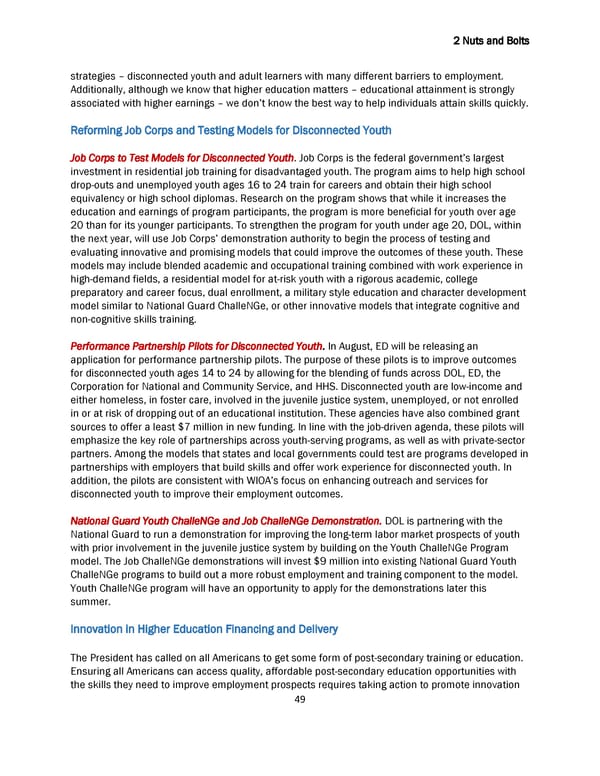2 Nuts and Bolts strategies – disconnected youth and adult learners with many different barriers to employment. Additionally, although we know that higher education matters – educational attainment is strongly associated with higher earnings – we don’t know the best way to help individuals attain skills quickly. Reforming Job Corps and Testing Models for Disconnected Youth Job Corps to Test Models for Disconnected Youth. Job Corps is the federal government’s largest investment in residential job training for disadvantaged youth. The program aims to help high school drop-outs and unemployed youth ages 16 to 24 train for careers and obtain their high school equivalency or high school diplomas. Research on the program shows that while it increases the education and earnings of program participants, the program is more beneficial for youth over age 20 than for its younger participants. To strengthen the program for youth under age 20, DOL, within the next year, will use Job Corps’ demonstration authority to begin the process of testing and evaluating innovative and promising models that could improve the outcomes of these youth. These models may include blended academic and occupational training combined with work experience in high-demand fields, a residential model for at-risk youth with a rigorous academic, college preparatory and career focus, dual enrollment, a military style education and character development model similar to National Guard ChalleNGe, or other innovative models that integrate cognitive and non-cognitive skills training. Performance Partnership Pilots for Disconnected Youth. In August, ED will be releasing an application for performance partnership pilots. The purpose of these pilots is to improve outcomes for disconnected youth ages 14 to 24 by allowing for the blending of funds across DOL, ED, the Corporation for National and Community Service, and HHS. Disconnected youth are low-income and either homeless, in foster care, involved in the juvenile justice system, unemployed, or not enrolled in or at risk of dropping out of an educational institution. These agencies have also combined grant sources to offer a least $7 million in new funding. In line with the job-driven agenda, these pilots will emphasize the key role of partnerships across youth-serving programs, as well as with private-sector partners. Among the models that states and local governments could test are programs developed in partnerships with employers that build skills and offer work experience for disconnected youth. In addition, the pilots are consistent with WIOA’s focus on enhancing outreach and services for disconnected youth to improve their employment outcomes. National Guard Youth ChalleNGe and Job ChalleNGe Demonstration. DOL is partnering with the National Guard to run a demonstration for improving the long-term labor market prospects of youth with prior involvement in the juvenile justice system by building on the Youth ChalleNGe Program model. The Job ChalleNGe demonstrations will invest $9 million into existing National Guard Youth ChalleNGe programs to build out a more robust employment and training component to the model. Youth ChalleNGe program will have an opportunity to apply for the demonstrations later this summer. Innovation in Higher Education Financing and Delivery The President has called on all Americans to get some form of post-secondary training or education. Ensuring all Americans can access quality, affordable post-secondary education opportunities with the skills they need to improve employment prospects requires taking action to promote innovation 49
 Biden Ready to Work White Paper 7/22/14 Page 48 Page 50
Biden Ready to Work White Paper 7/22/14 Page 48 Page 50